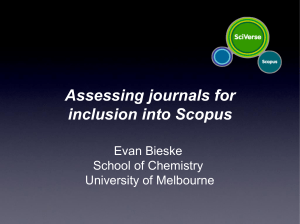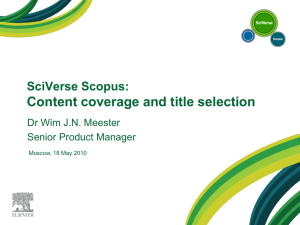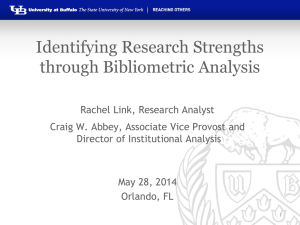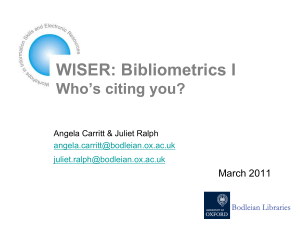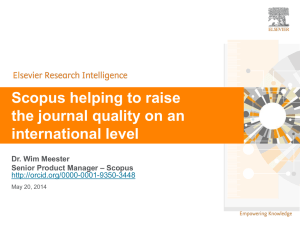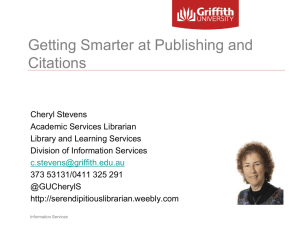Scopus
advertisement
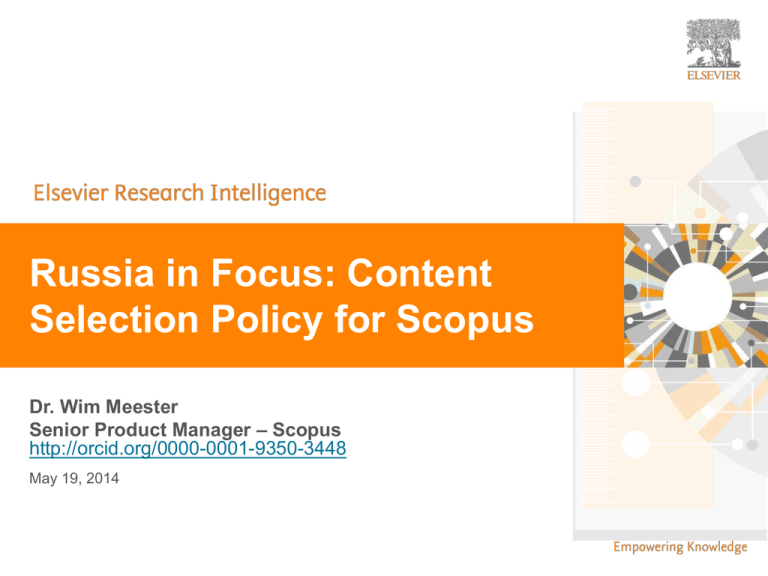
| Russia in Focus: Content Selection Policy for Scopus Dr. Wim Meester Senior Product Manager – Scopus http://orcid.org/0000-0001-9350-3448 May 19, 2014 0 | Layout of the presentation • Scopus content coverage • Scopus coverage of Russian content • How does Scopus select journal content? • How does Scopus select non-serial content (books and conferences) • What content expansion programs are ongoing? 1 | Scopus content coverage 2 | What content does Scopus include? 53.3M records from 21,912 serial titles and 36,000 books 21.3M pre 1996 records | 32.0M post 1995 records • • • • • Content from > 5,000 publishers “Articles in Press” from > 3,750 titles Titles from 105 different countries in all geographical regions 40 “local” languages covered More than 2,800 Gold Open Access journals indexed Scopus is ideal compared to other products because it has the broadest coverage of global, curated, relevant research, with smart, simple tools to help track, analyze and visualize research. 3 | Scopus covers different source types for a reason JOURNALS • Timely • Peer-reviewed (formal research) All subject fields, but typical fields with high ratio of journal publication: chemical, biological, health sciences etc. CONFERENCES BOOKS • Preliminary research (can be a bit less formal) • Newer ideas • Thorough analysis of a specific topic Mainly of importance in Computer Science and Engineering-related subject fields Mainly of importance in Social Sciences and the Arts & Humanities Different source types are added to ensure that coverage, discoverability, profiles and impact measurement for research in all subject fields is accounted for in Scopus. 4 | 5 What content does Scopus include? Physical Sciences 6,600 Health Sciences 6,300 Social Sciences 6,350 Life Sciences 4,050 JOURNALS CONFERENCES BOOKS PATENTS 20,874 peer-reviewed journals 367 trade journals 17k events 5.5M records (10%) 421 book series - 28K Volumes - 925K items 24M patents from 5 major patent offices - Full metadata, abstracts and cited references (pre-1996) - >2,800 fully Open Access titles - Going back to 1823 - Funding data from acknowledgements Conf. expansion: 1,000 conferences 6,000 conf. events 400k conf. papers 5M citations Mainly Engineering and Physical Sciences 34,485 books - 356K items Books expansion: 75K books by 2015 - Focus on Social Sciences and A&H | Scopus article growth over years 6 | Ratio of journals per Publisher in Scopus Source: Scopus title list (May 2014) 7 | Comparison with nearest peer ~24K titles ~12K titles Scopus 24,169 >5,000 publishers Web of Science 12,491 Updated daily 3,300 publishers Updated weekly Scopus 7,410 (+78%) Scopus 6,740 (+97%) Scopus 4,436 (+50%) Scopus 7,684 (+90%) WoS 4,188 WoS 3,415 WoS 2,954 WoS 4,016 Physical Sciences Health Sciences Life Sciences Social Sciences Source: Web of Science Real Facts, Web of Science title list and Scopus’ own data (April 2014) 8 | 9 Breadth of coverage in Russia Documents with Russian country affiliation 2009–2013 42,238 37,769 43,166 44,529 38,975 214 active journals from Russia in Scopus. + 118 Russian titles published by international publishers (332 active titles total) Proportion of languages of articles with Russian country affiliation: Russian 18% Other 1% English 81% Social Sciences Life Sciences Source: Scopus data 13 May 2014 Health Sciences Physical Sciences | How does Scopus select journals? 10 | How does Scopus select serial content? • • Titles are selected by the independent Content Selection & Advisory Board (CSAB) The CSAB is chosen for their expertise in specific subject areas; many will have previously been (journal) Editors Focus on quality through content selection by the independent CSAB, because: • • • • Provide accurate and relevant search results for users No dilution of search results by irrelevant or low quality content Support that Scopus is recognized as authoritative Support confidence that Scopus “reflects the truth” 11 | Transparent title evaluation process by an independent Content Selection & Advisory Board Publisher or Editor Review titles and make decision Suggest title Check Min. criteria “Enrich” titles CSAB External reviewer Continuous review process using aonline Scopus Title Evaluation Platform (STEP) Online suggestion form: http://suggestor.step.scopus.com/index.cfm 12 | 13 How does Scopus select serial content? All titles should meet all minimum criteria in order to be considered for Scopus review: Peer-review English abstracts Regular publication Roman script references Pub. ethics statement Eligible titles are reviewed by the Content Selection & Advisory Board according to a combination of 14 quantitative and qualitative selection criteria: Journal Policy • Convincing editorial concept/policy • Type of peer-review • Diversity geographic distribution of editors • Diversity geographic distribution of authors Quality of Content Journal Standing Regularity • Academic • Citedness of journal • No delay in contribution to the articles in Scopus publication schedule field • Editor standing • Clarity of abstracts • Quality and conformity with stated aims & scope • Readability of articles Info: http://www.elsevier.com/online-tools/scopus/content-overview Questions: titlesuggestion@scopus.com Online Availability • Content available online • English-language journal home page • Quality of home page | Importance of English language information in Scopus 14 | Capture English language information from the source 15 | 16 Scopus title review results and resources In total 3,914 titles reviewed (2011 –2013) of which 1,844 (47%) accepted for Scopus Titles reviewed top 20 countries (2013): As a primary publisher and information aggregator, Elsevier understands the unique needs of Authors, Editors and Publishers and provides resources to support the research community: • Advice from CSAB and FAQs available on Scopus info site • Publication ethics resources via Publishing Ethics Resource Kit (PERK) and Committee on Publication Ethics (COPE) • Translation, editing and publishing services • Elsevier.com Editors section (for ELS editors but applicable to all) • Freely available journal metrics to compare & assess journal performance • Trends in research via Research Trends newsletter Accepted Rejected | How does Scopus select non-serial content? 17 | 18 Selection of non-serial Book and Conference content Books Book selection is via a publisher-based approach (no individual suggestions accepted). All books from selected publishers deemed “in scope” will be selected for coverage. Priority and selection of publisher’s book lists depends on: • Reputation and impact of the publisher • Size and subject area of the books list • Availability and format of the book content • Publication policy and editorial mission • Quality of published book content Conferences Engineering related conferences 2005 going forward included on various vetted lists (no individual suggestions accepted). • Australian Research Council: ARC-A, ARC-B • “MIT” Conferences • DBLP Computer Science Bibliography (orig. db logic program bibliography) • Microsoft Academic Science – Computer Science, Engineering • INSPIRES – high-energy physics (Stanford) • Web of Science – selected engineering-focused/related • OnePetro – Oil & Gas industries (society conferences from API, SPE, NACE, SEG, etc.) • OneMine – mining and minerals (society conferences from SME, TMS, AIME, AusIMM, ...) | What content expansion projects are ongoing? 19 | 20 Conference Expansion Program Coverage years • Backfill from 2005 – 2012 (8 years) Number of conferences • Around 1,000 new conference titles, 6,000 conference events, 400K conference papers and 5M references Which conferences • Serial and one-off conferences from authoritative, respected lists. Focus on engineering and engineering-related subject fields Project started in 2011 A special project, designed to ensure Scopus (and Compendex) customers have access to highly regarded conferences from specific respected/authoritative lists of conferences held worldwide. Expected project end date: June 2014 | 21 Books expansion program (plus ~28K book Volumes from series) 70,000 60,000 Coverage years • Back to 2005 (2003 for A&H) 50,000 40,000 Number of books • 75,000 over three years; 10,000 each year thereafter 30,000 20,000 10,000 Book types • Monographs, edited volumes, major reference works, graduate level text books Book title Chapter title All chapter titles and links Author data Abstract Citation count Metadata Cited references Books target in Scopus Actual books in Scopus 0 Already in Scopus: Elsevier, Springer, Wiley, Brill, De Gruyter, Woodhead, Karger, Oxford University Press, Edward Elgar, Maney, Intellect, IOS Press, Pan Stanford, University of California Press, Princeton University Press, Edinburgh University Press, Delft University Press, Duke University Press, McGill Queens University Press, Project Muse (60+ UPs), OECD and more… | Pre-1996 cited references expansion program What? Why? Coverage years Number of articles Which Archives • Pre-1996, going back to 1970 • We estimate 8M+ articles will be (re-) processed to include cited references - Improve the completeness and coverage of back files in Scopus - Enhance the relevancy and visibility of archival content in Scopus - Measure the impact of pre-1996 – for both individual assessment and (historical) trend analysis. - Increase the accuracy of Scopus Author Profiles for older researchers and decision makers. • Archives from all major publishers that have digital archives available • All subject areas included When? Development of required systems and processes has already started The first content with pre-1996 cited references will be visible in Q4 2014 Completed by 2016 when >8M articles from all major publishers have been loaded 22 | Summary Scopus has broad coverage providing the most accurate view of the global research landscape. Scopus has a transparent content selection process executed by the independent Content Selection & Advisory Board. Scopus is flexible and we work with you and the research community to ensure that most relevant sources are covered. Scopus is working on content expansion programs to ensure that coverage, discoverability, profiles and impact measurement for research in all subject fields is accounted for in Scopus. 23 | Спасибо! Thank you & Questions Look out for more developments from Scopus @ http://blog.scopus.com/ http://twitter.com/Scopus www.elsevier.com/scopus 24
